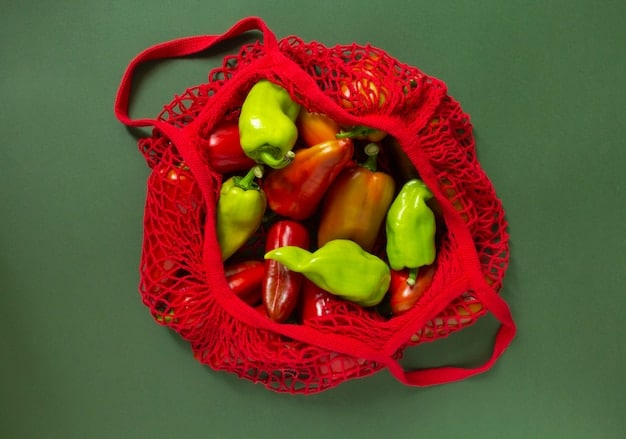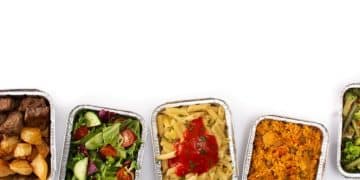Healthy Eating, Tight Budget: Smart Grocery Shopping Tips

Healthy eating on a budget is attainable through smart grocery shopping by planning meals, utilizing coupons, buying in bulk, and prioritizing seasonal produce.
Discover practical strategies for healthy eating on a budget, transforming your grocery shopping habits to save money without sacrificing nutrition. This guide offers actionable tips to help you make informed choices and enjoy delicious, healthy meals while staying within your financial means.
plan Your Meals and Shopping List
Planning your meals ahead of time is essential for healthy eating on a budget. By taking the time to organize your meals, you’ll be better equipped to shop efficiently and avoid impulsive purchases.
Creating a shopping list ensures that you buy only what you need, preventing food waste and overspending.
Start with a Meal Plan
Begin by planning your meals for the week. Consider your schedule and the number of meals you’ll need to prepare. Think about using versatile ingredients that can be incorporated into multiple dishes.
Create a Detailed Shopping List
Once you have a meal plan, create a detailed shopping list based on the ingredients you need. Check your pantry and fridge before heading to the store to avoid buying duplicates.

- Prioritize essential ingredients: Focus on purchasing the core ingredients for your planned meals.
- Organize your list by store sections: Group similar items together (e.g., produce, dairy, pantry staples) to streamline your shopping.
- Stick to the list: Resist the urge to buy items that aren’t on your list to avoid unnecessary spending.
In conclusion, meal planning and list-making are crucial first steps in healthy eating on a budget. They provide structure and intention to your grocery shopping, leading to smarter purchasing decisions.
Take Advantage of Coupons and Discounts
Coupons and discounts can significantly reduce your grocery bill, making healthy eating on a budget much easier. Utilizing these resources requires some effort, but the savings can be substantial.
Explore various avenues for finding and using coupons to maximize your savings potential.
Where to Find Coupons
Coupons are available from several sources, both online and offline. Check newspapers, store flyers, and manufacturers’ websites for potential discounts.
Digital Couponing
Many stores now offer digital coupons that can be loaded onto your loyalty card or accessed through their mobile app. Take advantage of these digital offers for extra savings.
- Sign up for store loyalty programs: These programs often provide exclusive coupons and discounts to members.
- Use coupon apps and websites: Many apps and websites aggregate coupons from various sources, making it easy to find the best deals.
- Combine coupons with sales: Maximize your savings by using coupons on items that are already on sale.
In summary, coupons and discounts are powerful tools for healthy eating on a budget. By actively seeking out and utilizing these opportunities, you can significantly lower your grocery expenses.
Buy in Bulk When It Makes Sense
Buying in bulk can be a cost-effective strategy for certain items, contributing to healthy eating on a budget. However, it’s important to make informed decisions to avoid waste and overspending.
Focus on purchasing non-perishable items in bulk and consider splitting bulk purchases with friends or family members.
Consider Non-Perishable Items
Dried beans, rice, oats, and nuts are examples of non-perishable items that can be purchased in bulk without worrying about spoilage. These staples form the foundation of many healthy meals.
Proper Storage
To maintain the quality of your bulk purchases, proper storage is essential. Use airtight containers to protect food from moisture, pests, and light.

- Compare unit prices: Check the unit prices (price per ounce or pound) to ensure that buying in bulk is actually cheaper.
- Only buy what you can use: Avoid purchasing excessive quantities of items that you may not be able to consume before they expire.
- Consider storage space: Make sure you have adequate storage space for bulk items before making a purchase.
In conclusion, buying in bulk can be a smart way to save money and support healthy eating on a budget, provided you choose the right items and store them properly.
Prioritize Seasonal Produce
Choosing seasonal produce is a key aspect of healthy eating on a budget. When fruits and vegetables are in season, they are typically more abundant and less expensive.
Enjoy the freshest and most affordable produce by adapting your meal choices to the seasons.
Benefits of Seasonal Eating
Seasonal produce not only tastes better but also tends to be more nutritious. Locally grown, seasonal items are harvested at their peak ripeness and haven’t traveled long distances.
Market Research
Take a look at your local market or grocery stores for seasonal price drops. This will help you plan your meals according to what is freshest and most affordable.
- Visit farmers’ markets: Farmers’ markets often offer a wide selection of seasonal produce at competitive prices.
- Check weekly flyers: Grocery stores frequently feature seasonal produce in their weekly flyers.
- Learn about seasonal availability: Familiarize yourself with which fruits and vegetables are in season in your region at different times of the year.
In summary, prioritizing seasonal produce is a smart and sustainable practice for healthy eating on a budget. It allows you to enjoy fresh, flavorful, and nutritious foods while saving money.
Cook More Meals at Home
Cooking more meals at home is a fundamental strategy for healthy eating on a budget. Restaurant meals and takeout can be significantly more expensive than preparing food yourself.
Embrace home cooking as a way to control ingredients, portions, and costs, leading to both financial and health benefits.
Explore Simple Recipes
You don’t need to be a culinary expert to cook delicious and healthy meals at home. Focus on simple recipes that require minimal ingredients and cooking time.
Batch Cooking
Consider cooking large batches of food on the weekends and portioning them out for lunches and dinners during the week. This saves time and reduces the temptation to order takeout.
- Invest in essential kitchen tools: A few basic kitchen tools (pots, pans, knives, cutting boards) can make cooking at home easier and more enjoyable.
- Plan your meals in advance: Knowing what you’re going to cook each day helps you shop efficiently and avoid last-minute takeout orders.
- Get creative with leftovers: Transform leftovers into new dishes to minimize food waste and add variety to your meals.
In conclusion, cooking more meals at home is a cost-effective path to healthy eating on a budget. It puts you in control of your food choices and helps you save significantly on dining expenses.
Avoid Processed Foods and Sugary Drinks
Reducing your consumption of processed foods and sugary drinks is essential for both your health and your wallet, contributing to healthy eating on a budget. These items are often high in calories, low in nutrients, and expensive.
Opt for whole, unprocessed foods and water or unsweetened beverages to support your health and financial goals.
Focus on Whole Foods
Whole foods are foods that are as close to their natural state as possible. Examples include fruits, vegetables, whole grains, lean proteins, and healthy fats.
Smart Substitutions
Replace sugary sodas and juices with water, herbal tea, or homemade infused water. Trade processed snacks for fresh fruits, vegetables, nuts, or yogurt.
- Read nutrition labels carefully: Pay attention to serving sizes, calories, added sugars, and unhealthy fats.
- Plan your snacks: Pack healthy snacks to avoid impulsive decisions when hunger strikes.
- Limit processed foods: Reduce your intake of packaged snacks, convenience meals, and processed meats.
In summary, avoiding processed foods and sugary drinks is a key strategy for healthy eating on a budget. This shift in priorities enhances both your nutritional intake and your savings.
Grow Your Own Food
Consider growing some of your own food; even a small garden can significantly contribute to healthy eating on a budget. Growing your own food can be particularly rewarding if you have a bit of land, it reduces grocery costs, ensures the freshness of your produce, and promotes a sustainable lifestyle.
Consider starting with easy-to-grow options and gradually expand your garden as you gain experience.
Easy-to-Grow Options
Herbs such as basil, mint, and chives are relatively easy to grow and can be added to a variety of dishes. Leafy greens like lettuce and spinach are also good choices for beginners.
Container Gardening
If you lack garden space, consider container gardening. Many vegetables and herbs can be successfully grown in pots on a balcony or patio.
- Start small: Begin with a few plants and gradually expand your garden as you gain confidence.
- Choose the right location: Ensure your plants receive adequate sunlight and water.
- Use organic gardening practices: Avoid using synthetic pesticides and fertilizers to protect your health and the environment.
In summary, growing your own food, even on a small scale, can significantly contribute to healthy eating on a budget. It gives you greater control over the quality and cost of your produce, while also providing a fulfilling hobby.
| Key Point | Brief Description |
|---|---|
| 📝 Meal Planning | Plan meals and shopping lists to avoid impulse buys and food waste. |
| 💰 Coupons | Use coupons and discounts from various sources to reduce costs. |
| 🛒 Bulk Buying | Buy non-perishable items in bulk if cheaper per unit. |
| 🍎 Seasonal Produce | Prioritize seasonal fruits and vegetables for freshness and affordability. |
FAQ
▼
Affordable protein sources include lentils, beans, eggs, canned tuna, and tofu. These options are nutritious and budget-friendly, making them great additions to your diet.
▼
Reduce food waste by planning your meals, storing food properly, using leftovers creatively, and composting food scraps. These practices help save money and reduce environmental impact.
▼
Prioritize buying organic for produce with thin skins or that you consume frequently, like berries and leafy greens. This helps minimize exposure to pesticides while staying within budget.
▼
Staple foods include rice, beans, oats, eggs, pasta, and frozen vegetables. These versatile ingredients can be used in various dishes and have a long shelf life.
▼
Make healthy eating a sustainable habit by setting realistic goals, involving family members, tracking your progress, and celebrating small victories. Consistency is key to long-term success.
Conclusion
Incorporating these simple yet effective tips into your grocery shopping routine can make healthy eating on a budget a realistic and sustainable goal. By planning, utilizing resources wisely, and making informed choices, you can nourish your body without breaking the bank.





